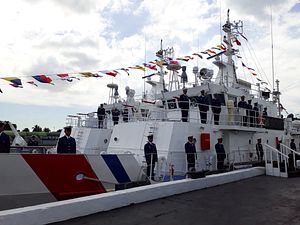Earlier this week, the Philippine Coast Guard (PCG) commissioned three new vessels from Japan amid the commemoration of its anniversary. The development once again placed the spotlight on the vital capacity-building assistance Tokyo continues to provide to Manila as well as the broader trend of continuing defense collaboration that has endured between the two sides despite the challenges posed by the rise of Philippine President Rodrigo Duterte.
As I have been noting in these pages, despite lingering uncertainties and some refocusing following the election of Duterte, Japan-Philippines defense ties have nonetheless continued strengthening in some areas of the maritime realm as part of their broader partnership (See: “Japan-Philippines Defense Relations Under Duterte: Full Steam Ahead?”). Indeed, security ties have factored into a busy last few weeks for the relationship, which included Duterte visiting Tokyo last month and Abe visiting Manila last week for the recent round of ASEAN summitry, which the Philippines is hosting as the holder of the annually rotating ASEAN chairmanship.
As I have observed before, the PCG and the Philippine Navy need all the help they can get from allies and partners like the United States, Japan, and Australia, particularly in the maritime realm where there is a need to cover over 7,000 islands with a tenth of the world’s coastline (See: “Where is the Philippines Coast Guard in its Military Modernization?”). The Philippines also faces a wide range of challenges including not just the South China Sea, which tends to dominate foreign commentary, but also a range of transnational challenges in the Sulu-Sulawesi Seas and the renewed threat of terrorism from the Islamic State, which persists even after the end of the siege in the southern city of Marawi (See: “ASEAN’s Post-Marawi Islamic State Challenge”).
One of the most visible manifestations of Japan-Philippines security ties has been the much-needed capacity-building Tokyo is providing Manila through the Maritime Safety Capability Improvement Project (MSCIP), an official development assistant project financed by loans extended by the Japan International Cooperation Agency (JICA). Of the ten multi-role response vessels (MRRVs) initially pledged to be delivered under Phase I of MSCIP, three of them were delivered last year, three of them had arrived earlier this year, and the remaining four are to be delivered next year.
On November 20, as officials from both sides had indicated in advance, the PCG commissioned three more of the Japan-made 44-meter Parola-class MRRVs in a ceremony that coincided with its 116th founding anniversary. The newly commissioned vessels – BRP Capones (MRRV-4404), BRP Suluan (MRRV-4406), and BRP Sindangan (MRRV-4407) – had arrived between March and August this year.
Philippine officials have been playing up the role that these vessels will play in terms of addressing the challenges the country faces. During the November 16 visit of Kenataro Sonoura, the special adviser to the prime minister of Japan, to PCG headquarters, which occurred just days before the commissioning ceremony, National Security Adviser Hermogenes Esperon Jr. had told reporters that three or four of the vessels would be immediately deployed to the South China Sea following commissioning, apart from their stated use for a wide range of activities including search and rescue, anti-terrorism, and law enforcement.
Those remarks came amid continued concerns raised by some about the Duterte administration’s failure to effectively manage the old risks inherent in engaging China on the South China Sea issue despite its focus on the new opportunities therein (See: “Beware the New China-Philippines South China Sea Deal”).
Apart from the MRRVs, one important development that did not make as much of a splash was Japan’s turning over three seven-meter rigid hull inflatable boats (RHIBs) to the PCG as well following the ceremony. More of these RHIBs are expected to be delivered in 2018 in line with a pledge made by Japan earlier this year. Philippine defense officials had previously said that the ships would be useful for a variety of tasks, including deployments in the southern Philippines to fight sea piracy.
Beyond these manifestations of capacity-building that tend to be the most visible aspects of Japan-Philippines defense ties, officials from both sides are keen to emphasize that there are other areas of cooperation, be it Japanese specialists training Philippine personnel on aspects of maritime security or other low-visibility exercises and interactions. And indications are that more is on the way as well, be it in terms of bigger vessels or radar systems as Japan seeks to develop its defense ties with the Philippines as well as other ASEAN states (See: “Japan Reveals First ASEAN Defense Initiative with Vientiane Vision”). All this suggests that developments in this space will continue to be interesting to watch in the coming months.
































